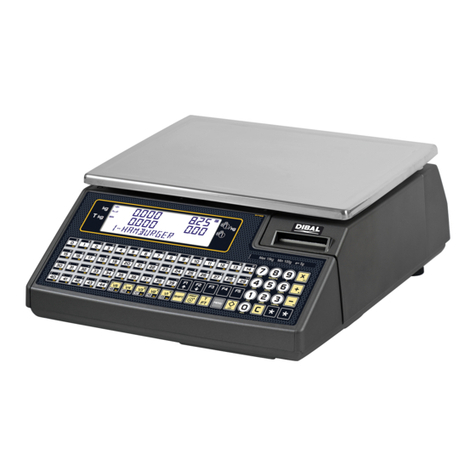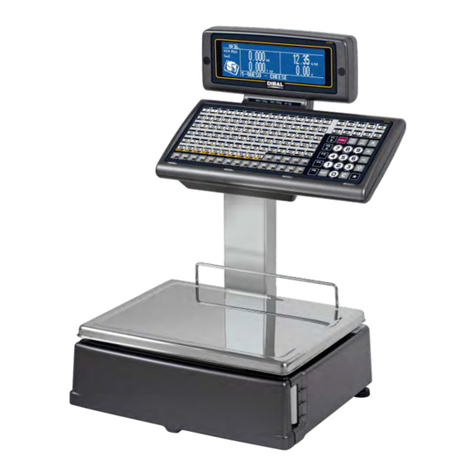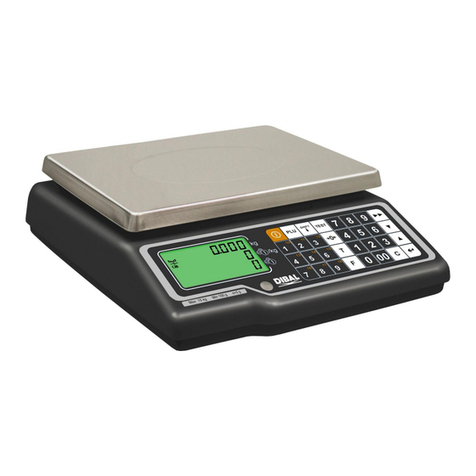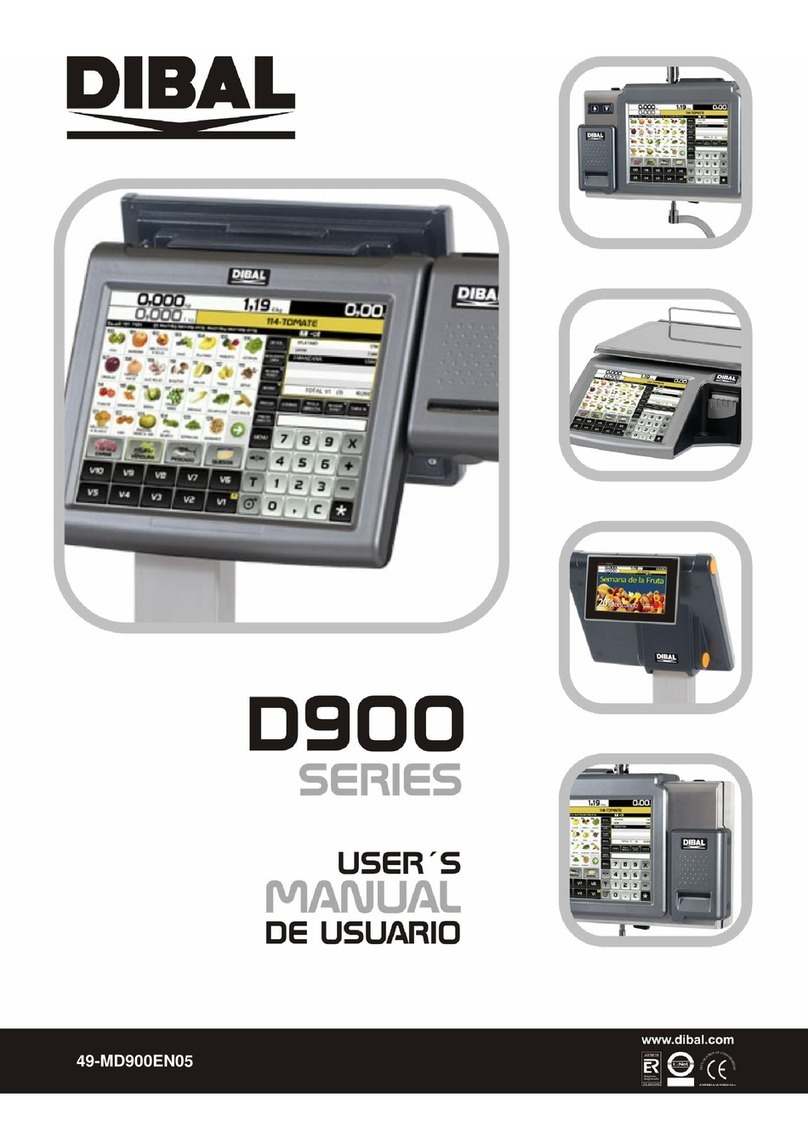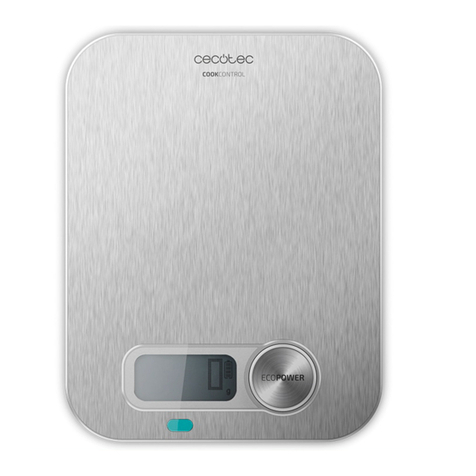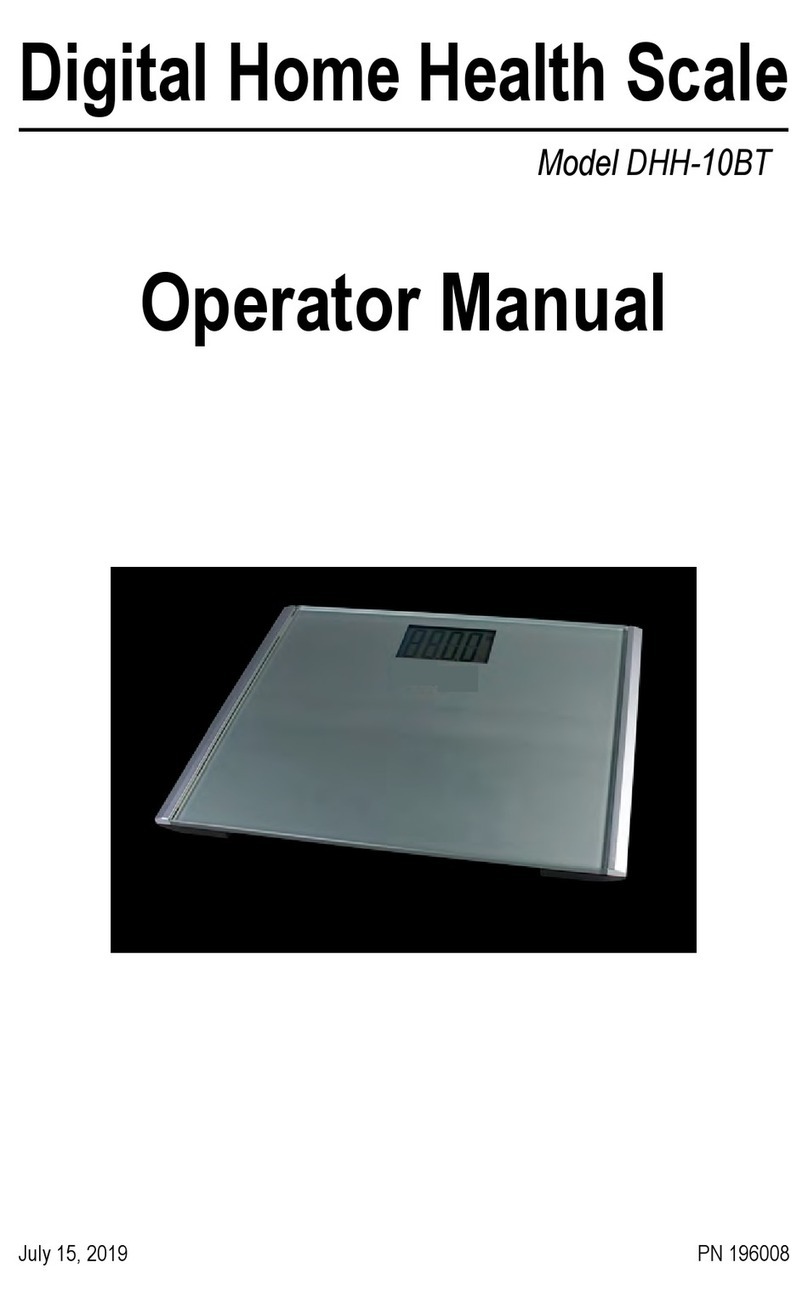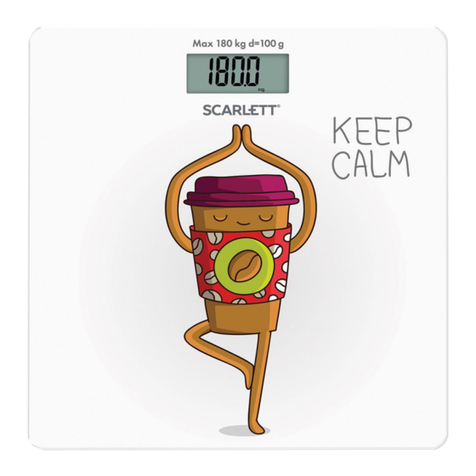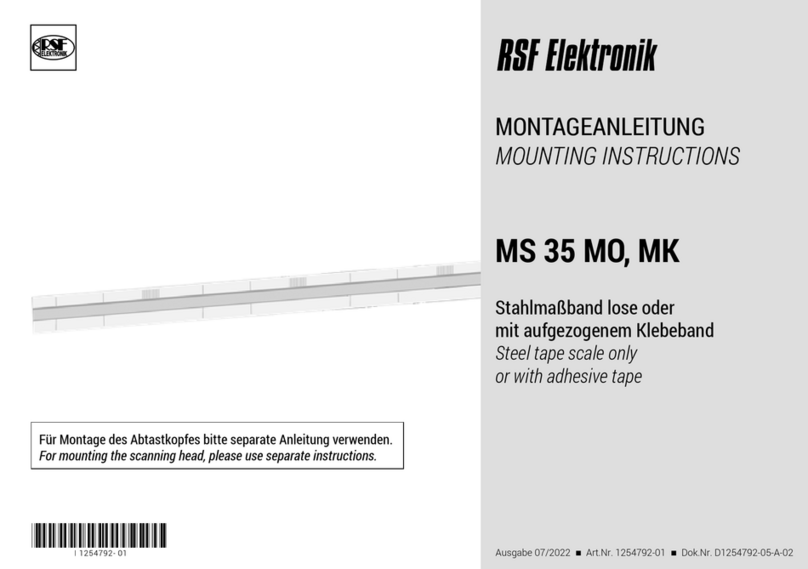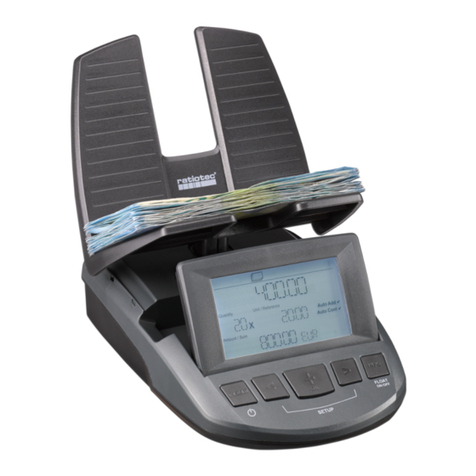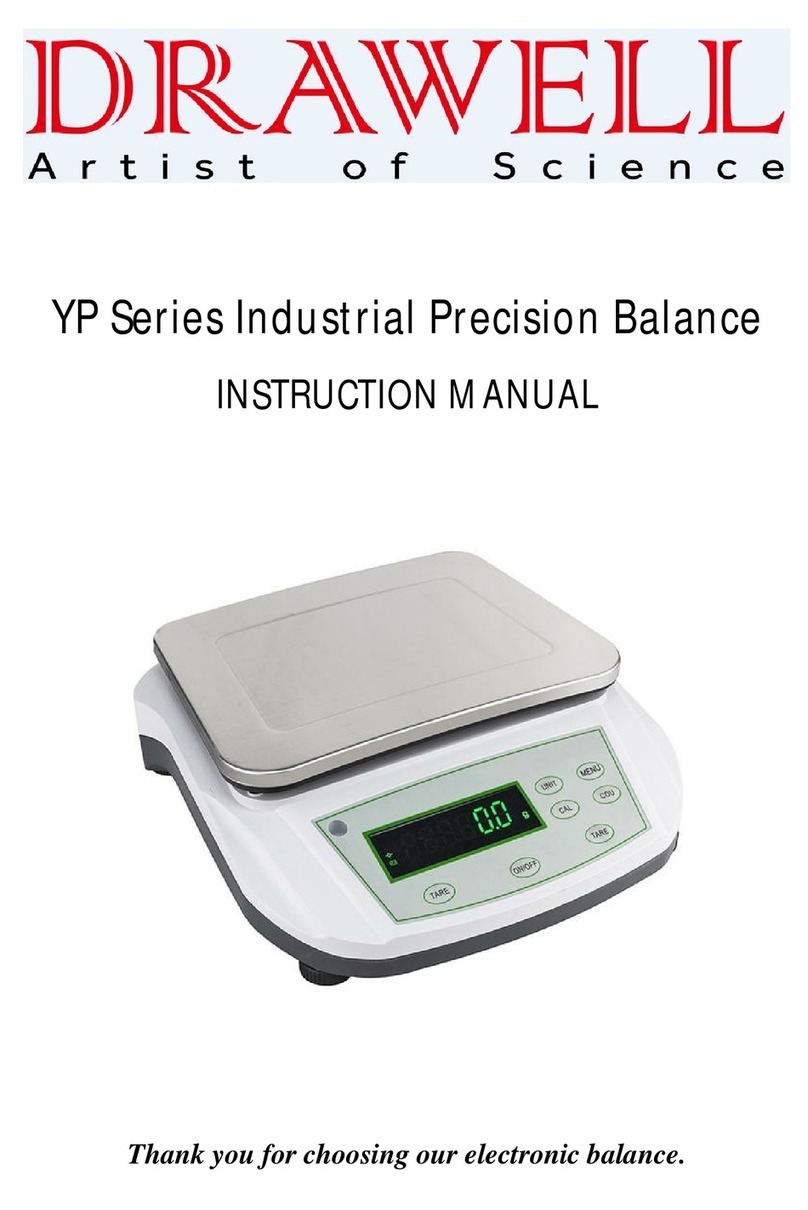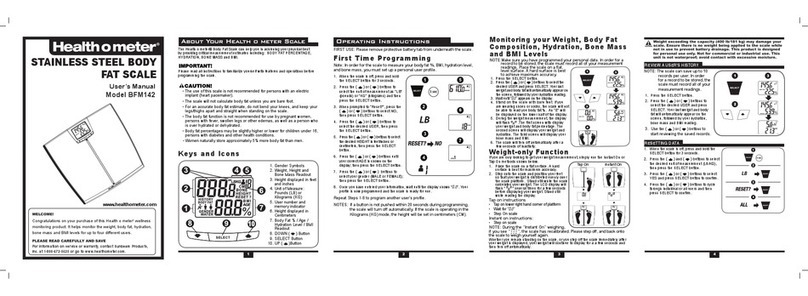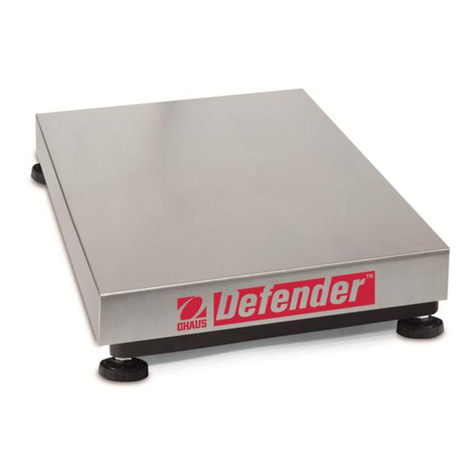Dibal DPOS400 SERIE Guide

TEST AND ADJUSTMENTS MANUAL
DPOS400
SERIE
Ref:: 49-TGDP4ES02 –V.1.08


I
INDEX
1. TEST..........................................................................................................................................................................1
1.1 ENTERING TEST MODE .................................................................................................................................1
1.2 DISPLAY TEST.................................................................................................................................................2
1.3 KEYBOARD TEST............................................................................................................................................2
1.4 EURO PHASE ........................................................................................................................................................3
2CALIBRATION........................................................................................................................................................4
2.1 COUNTRY.........................................................................................................................................................4
2.2 IML PROGRAMMING......................................................................................................................................5
2.3 CAPACITY PROGRAMMING .........................................................................................................................5
2.4 ADJUSTMENT ..................................................................................................................................................5
2.4.1 LATITUDE ADJUSTMENT........................................................................................................................5
2.4.2 ALTITUDE ADJUSTMENT........................................................................................................................6
2.4.3 ZERO WEIGHT ADJUSTMENT.................................................................................................................7
2.4.4 WEIGHT ADJUSTMENT............................................................................................................................7
3COMMUNICATIONS.............................................................................................................................................8
3.1 COMMUNICATION PARAMETERS...............................................................................................................9
3.2 PROTOCOL SELECTION...............................................................................................................................10
3.3 POINT/COMA CONFIGURATION................................................................................................................11
4PROTOCOLS TYPE..............................................................................................................................................12
4.1 ANKER CASH REGISTER PROTOCOL..................................................................................................................12
4.2 TPV CASIO CE PROTOCOL...............................................................................................................................13
4.3 RIVA /UNIWELL CASH REGISTER PROTOCOL .................................................................................................14
4.4 TISA CASH REGISTER PROTOCOL.......................................................................................................................15
4.5 EAN TO PC ICL CASH REGISTER PROTOCOL......................................................................................................16
4.6 SANYO CASH REGISTER PROTOCOL..................................................................................................................17
4.7 APOLLO /SAMSUNG POLONIA CASH REGISTER PROTOCOL........................................................................18
4.8 DELTA CASH REGISTER PROTOCOL...................................................................................................................19
4.9 ALFA CASH REGISTER PROTOCOL .....................................................................................................................19
4.10 SAMSUNG-SPAIN CASH REGISTER PROTOCOL................................................................................................20
4.11 SAMSUNG PORTUGAL CASH REGISTER PROTOCOL ......................................................................................20
4.12 UNIPROX /BMC PS 2000 CASH REGISTER PROTOCOL ....................................................................................21
4.13 UNIPROX CASH REGISTER PROTOCOL WITH CHECKSUM ..............................................................................21
4.14 SHARP UP-700 CASH REGISTER PROTOCOL......................................................................................................22
4.15 KABEL CASH REGISTER PROTOCOL ..................................................................................................................24
4.16 NCI CASH REGISTER PROTOCOL.........................................................................................................................25
4.17 ECR-POSNET PROTOCOL (SAMSUNG POLAND VARIANT) ..........................................................................27
4.18 TISA PROTOCOL (WITH STABLE WEIGHT SEND) .................................................................................................28
4.19 VD TISA PROTOCOL .........................................................................................................................................28
4.20 VD SEUR PROTOCOL........................................................................................................................................29
4.21 UNIPROX PROTOCOL (WITH 6DIGITS FOR PRICE).............................................................................................29
4.22 STAR PROTOCOL (WITH STABLE WEIGHT SEND)................................................................................................30
4.23 RESERVED .........................................................................................................................................................30
4.24 DIALOG 06 PROTOCOL ....................................................................................................................................31
4.25 EUROSTAR 2000T ALPHA PROTOCOL (LITHUANIA).................................................................................34
4.26 RESERVED .........................................................................................................................................................34
4.27 DATECS PROTOCOL.........................................................................................................................................35
4.28 NEW CASIO TPV PROTOCOL ...........................................................................................................................36
4.29 RESERVED .........................................................................................................................................................36
4.30 DIALOG 06 PROTOCOL WITHOUT ATTEND TO MINIMUM WEIGHT......................................................................37
4.31 ELZAB PROTOCOL............................................................................................................................................40
4.32 TOWA PROTOCOL ............................................................................................................................................42
4.33 SHARP UP-700-2 CASH REGISTER PROTOCOL ..................................................................................................44
4.34 QT-6000 CASH REGISTER PROTOCOL.................................................................................................................46
4.35 OLIVETTI CASH REGISTER PROTOCOL .............................................................................................................47

II
4.36 TF-1000 PROTOCOL...........................................................................................................................................48
4.37 SHARP UP-800 CASH REGISTER PROTOCOL......................................................................................................49
4.38 IBM PROTOCOL.................................................................................................................................................51
4.39 DIALOG 06 PROTOCOL WITHOUT ATTEND TO TARE..........................................................................................52
4.40 DIALOG 06 PROTOCOL WITHOUT ATTEND TO TARE NEITHER MINIMUM WEIGHT...............................................55
4.41 RESERVED .........................................................................................................................................................57
4.42 DIBAL TERMINAL PROTOCOL...........................................................................................................................58
4.43 IBM/HUGIN "SERD" FOR CASH REGISTER CHD 3010 PROTOCOL...................................................................59
4.44 ANKER CASH REGISTER PROTOCOL WITH ZERO WEIGHT SENDING ....................................................................60
4.45 COM (DATECS 2) PROTOCOL..........................................................................................................................61
4.46 SAMSUNG-CHINA CASH REGISTER PROTOCOL...............................................................................................62
4.47 HUNAN WEIBOSHI PROTOCOL............................................................................................................................62
4.48 METTLER (PRECIA) PROTOCOL.....................................................................................................................63
4.49 CARREFOUR PROTOCOL.................................................................................................................................64
4.50 DIALOG 02/04 PROTOCOL ...............................................................................................................................65

DPOS 400
49-TGDP4ES02
1
1. TEST
The test functions permit the user to check all of the important elements of the scale in order to
assure that they function correctly; or in the case of a malfunction, find the faulty element quickly. The scale
must be turned off to leave test mode.
1.1 ENTERING TEST MODE
When the scale is turned on, a segment test is run showing a count down from 9 to 0. In order to
enter test mode, press the two outside keys on the bottom row of the keyboard: and , before the
countdown reaches 0. Backlighting is on while the equipment is in mode test.
The scale will show hyphens in all the display‟s digits, followed by the following information.
1. The weight value in grams is shown in the weight display.
2. The zero weight value in internal divisions is shown in the price per kilogram display. This value is
accompanied by a hyphen, which is in the center segment if the value is in the limits set when the
scale was adjusted or in the upper or lower segments if the value is greater or lesser than the
limits respectively.
3. The weight value in internal divisions is shown in the amount display.
This will be referred to as test ready, and is the beginning point for all the tests to be done.

Test y Ajustes
2
1.2 DISPLAY TEST
This allows the user to assure that there are no problems with the display. Being main screen of test
mode, press the key and then hold the key . Be careful, if you hold the key a lot of time, the
scale will shut down.
Press 3 times the key to return to the main screen.
1.3 KEYBOARD TEST
To verify the correct operation of keys is enough to press the different buttons and see if it beeps.
Filter
This adjustment allows choosing the working mode of the scale, only weight or price, weight amount. The
adjustment can take two different values, as is shows follow:
Filter = 0
Only weight
Filter = 1
Price, weight and amount
Press the key to enter to this menu. The value can be changed pressing the key .
Press 3 times the key to return to the main screen.

DPOS 400
49-TGDP4ES02
3
1.4 Euro phase
This adjustment indicates the phase of the Euro. To change the phase you have to enter the corresponding
code from attached table.
Press 2 times the key to enter to this menu.
To introduce the code you have to press again the key . Then press the key to change the first
number. Use the key to select the following number.
Press the key to apply the changes (if the code is incorrect the scale does not do anything) and return to
the main screen.
From
To
Code
Phase 0
Phase 1
0781
Phase 1
Phase 2
6022
Phase 2
Phase 3
9808
Return to initial phase
2149

Test y Ajustes
4
2 CALIBRATION
These functions allow the user to program, adjust and calibrate the scale.
The scale must be turned on for at least two hours before being adjusted. It must also be perfectly
level and the temperature and humidity must be stable. The user must have a calibrated weight relative to
the scale capacity.
The keys have the following functions:
Key
Function
Increase the programming value.
Decrease the programming value.
Accept the value and move on to the next.
Turn the scale on, and while it is counting down from 9 to 0, press the two keys together, and
; The scale will enter test ready. Next, press the adjustment key found on the CPU. This may be
accessed by removing the sealed screw and inserting a pointed object in the opening.
This should only be done by authorized personnel.
2.1 COUNTRY
Select the country code. The language of message and the rounding will modified according to the country.
To change the country press the key or . Press the key to program the next field.
Code
Country
Code
Country
40
Romania
60
Bahrain
41
-
61
Australia
42
Bulgaria
62
USA
43
-
63
India
44
South Africa
64
Emirates Arabs
45
Pakistan
65
Mexico
46
Thailand
66
Indonesia
47
Panama
67
Oman
48
Guatemala
68
Iran
49
Philippines
69
Egypt
50
-
70
French Polynesia
51
Cyprus
71
Switzerland
(French)
52
Algeria
72
Russia
53
Saudi Arabia
73
New Caledonia
54
Iceland
74
Jordan
55
Singapore
75
Malt
56
Lebanon
76
57
Vietnam
77
58
Kenya
78
59
Turkey
79
Code
Country
Code
Country
0
Spain
20
-
1
Deutschland
21
Denmark
2
Austria
22
Ukraine
3
Belgium Flemish
23
Poland
4
Belgium French
24
Ireland
5
Costa Rica
25
Holland
6
Estonia
26
Brazil
7
France
27
Argentina
8
Greece
28
Tunis
9
-
29
Serbia
10
UK
30
Morocco
11
Italy
31
Bosnia
12
Peru
32
Slovakia
13
Dominican Rep.
33
Croatia
14
Czech Republic
34
Colombia
15
Sweden
35
-
16
Switzerland
36
Slovenia
17
Venezuela
37
Latvia
18
Portugal
38
Hungary
19
Finland
39
Latvia

DPOS 400
49-TGDP4ES02
5
2.2 IML PROGRAMMING
This allows the user to set a series of parameters as recommended by the OIML. This parameter
cannot be modified.
Press the key to program the next field.
2.3 CAPACITY PROGRAMMING
This allows the scale capacity to be selected according to the following table.
Press the key to increase the programming value
Press the key to decrease the programming value
Press the key to program the next field.
2.4 ADJUSTMENT
This allows an adjustment to be done. The default value of 0 will always be shown. Change the
value pressing the key and then press the key to program the next field. Do not enter this option
if you are not qualified or if you do not have the calibrated weights.
This should only be done by authorized personnel.
The following sections will only be visible when this parameter will set to 1.
2.4.1 LATITUDE ADJUSTMENT
Code
Capacity
1
6 kg
2
15 kg
16
6/15 MR

Test y Ajustes
6
This allows the adjustment to be modified according to the latitude at which the scale is to operate
without carrying out a complete adjustment with calibrated weights. Program a value between 0 and 90.
Press the key to increase the programming value
Press the key to decrease the programming value
Press the key to program the next field.
2.4.2 ALTITUDE ADJUSTMENT
This allows the adjustment to be modified according to the altitude at which the scale is to operate
without carrying out a complete adjustment with calibrated weights. Program a value between 0 and 9999
corresponding to meters above sea level.
Press the key to increase the programming value
Press the key to decrease the programming value
Press the key to program the next field.

DPOS 400
49-TGDP4ES02
7
2.4.3 ZERO WEIGHT ADJUSTMENT
This will carry out an non-reversible calibration process with the scale. To do this adjustment, the
user must have the corresponding calibrated weights according to the maximum scale capacity. If the
adjustment is to be done, remove all of the weight from the plate and press the key to begin the zero
weight adjustment. During the adjustment process, the display will show hyphens. This process lasts
various seconds.
Press the key to increase the programming value
Press the key to decrease the programming value
Press the key to program the next field.
2.4.4 WEIGHT ADJUSTMENT
Once the zero weight adjustment is made, the display will show a default weight, relative to the scale
capacity, to be used in the weight adjustment. This adjustment weight may be modified by using the
keyboard. Place a calibrated weight matching exactly the weight shown in the display on the weighing
platform and wait a few seconds for the weight to stabilize. Press the key to begin the weight
adjustment. The display will show lines of hyphens while the adjustment is being done. This process will last
for a few seconds.
Once the adjustment process has been completed correctly, the scale will return to test ready
automatically. If an error occurs during the adjustment, the scale will show a message “Error ”. Press the
key to return to test ready and retry the adjustment process.

Test y Ajustes
8
3 COMMUNICATIONS
Model DPOS400 is capable of communicating with a computer.
The reference of the cable is BV-5858.
The scale DPOS400 is capable of communicating with a computer by USB. Is a standard cable with an A
connector on one end and a mini-B connector on the other end.
Never use a communications cable different to the one shown above.

DPOS 400
49-TGDP4ES02
9
3.1 COMMUNICATION PARAMETERS
The communications are going to be programmed in this menu. It is necessary select the parirty, the data
transfer rate, the bits numbers…
Hold the key until the next screen will appear. If you keep pressed a lot of time this key, the scale will
switch off.
Select the type of communication in accordance with the table below:
Type
Bauds
Data Bits
Stop Bits
Parity
Type
Bauds
Data Bits
Stop Bits
Parity
0
9600
8
1
No
20
4800
7
1
Even
1
9600
8
1
Even
21
4800
7
1
Odd
2
9600
8
1
Odd
22
4800
7
2
Even
3
9600
8
2
No
23
4800
7
2
Odd
4
9600
7
1
Even
24
2400
8
1
No
5
9600
7
1
Odd
25
2400
8
1
Even
6
9600
7
2
Even
26
2400
8
1
Odd
7
9600
7
2
Odd
27
2400
8
2
No
8
19200
8
1
No
28
2400
7
1
Even
9
19200
8
1
Even
29
2400
7
1
Odd
10
19200
8
1
Odd
30
2400
7
2
Even
11
19200
8
2
No
31
2400
7
2
Odd
12
19200
7
1
Even
32
1200
8
1
No
13
19200
7
1
Odd
33
1200
8
1
Even
14
19200
7
2
Even
34
1200
8
1
Odd
15
19200
7
2
Odd
35
1200
8
2
No
16
4800
8
1
No
36
1200
7
1
Even
17
4800
8
1
Even
37
1200
7
1
Odd
18
4800
8
1
Odd
38
1200
7
2
Even
19
4800
8
2
No
39
1200
7
2
Odd
Press the key to increase the programming value
Press the key to decrease the programming value
Press the key to program the next field.

Test y Ajustes
10
3.2 PROTOCOL SELECTION
In this menu you select one of the available protocols. Using this protocol the scale is able to communicate
with a POS or a cash register.
The following protocols are available:
Press the key to increase the programming value
Press the key to decrease the programming value
Press the key to program the next field.
Código
Protocolo
Código
Protocolo
1
ANKER
26
-------
2
TPV CASIO
27
DATECS
3
RIVA / UNIWELL
28
TPV CASIO NUEVO
4
TISA
29
-------
5
EAN a PC ICL
30
DIALOG 06 sin atender al peso mínimo
6
SANYO
31
ELZAB
7
APOLLO/SAMSUNG POLONIA
32
TOWA
8
DELTA
33
SHARP UP-700-2
9
ALFA
34
QT-6000
10
DOLAR/SAMSUNG ESPAÑA
35
OLIVETTI
11
SAMSUNG PORTUGAL
36
TF-1000
12
UNIPROX (BMC PS-2000)
37
SHARP UP-800
13
UNIPROX con checksum
38
IBM
14
SHARP UP-700
39
DIALOG 06 sin atender a la tara recibida
15
KABEL (ITALIA)
40
DIALOG 06 sin atender a peso mínimo ni
a la tara recibida
16
NCI
41
-------
17
ECR-POSNET
42
DIBAL Terminal
18
TISA con envío en peso estable
43
IBM/HUGIN "SERD" para cajas CHD
3010
19
VD TISA
44
ANKER con envío de peso cero
20
VD SEUR
45
COM (DATECS 2)
21
UNIPROX con 6 dígitos de precio
46
SAMSUNG CHINA
22
STAR (con envío en peso estable)
47
HUNAN WEIBOSHI
23
--------
48
METTLER (PRECIA)
24
Checkout_Dialog06
49
CARREFOUR
25
EUROSTAR 2000T ALPHA
50
DIALOG 02/04

DPOS 400
49-TGDP4ES02
11
3.3 POINT/COMA CONFIGURATION
In this menu you can switch the decimal point that separates the whole number and decimal part of price,
weight and amount. The default value is 0, which represents the decimal point as a point. Press the key
or to modify this value.
.
On the following pictures you can view the different representations.
Coma = 0
Coma =1
Pulse la tecla para volver a la pantalla principal.

Test y Ajustes
12
4 PROTOCOLS TYPE
In this section the protocols are going to be described. To select one of them, go to section 3.2 Protocol
selection.
4.1 ANKER cash register protocol
Protocol
Cash Register Scale
Sx01EcPPPPPEx
AK
Eq
Sx02Ec3EcWWWWWEcPPPPPEcIIIIIIEx
If the weight is unstable, zero, negative or out of range:
Sx01EcPPPPPEx
AK
Eq
NAK
Where:
Sx:0x02h AK:0x06h
01: 0x30h y 0x31h Ex: 0x03h
Ec:0x1Bh NAK: 0x15h
WWWWW: 5 characters for weight.
PPPPP: 5 characters for price.
IIIIII: 6 characters for amount.
NOTE:
-After the scale responds with AKwait for a second to receive Eq, if this time expired the scale do not
respond to Eq.
- Between different requests the weight must vary at least 20 steps or pass through zero, otherwise the
scale responds with NAK.
- If the weight is unstable, zero, negative or erroneous (with “-------“ on the display), the scale respond
with NAK.
- If the amount overflows the scale send 000000 in the field IIIIII.
- If the scale has a tare weight, it sends the net weight in the field WWWWW.

DPOS 400
49-TGDP4ES02
13
4.2 TPV CASIO CE protocol
Protocol
Cash Register Scale
Sx
Part 1
AK
Price send
@1PPPPPCRLF
Sx
AK
Part 2
10CRLF
Weight, amount, price request
Sx
AK
WWWWWPPPPPIIIIII0CRLF
Where:
Sx:0x02h AK: 0x06h
@1: 0x40h y 0x31h LF:0x0Ah
10: 0x31h y 0x30h NAK: 0x15h
CR: 0x0Dh
WWWWW: 5 characters for weight.
PPPPP: 5 characters for price.
IIIIII: 6 characters for amount.
NOTE:
- The protocol contains two parts; on the first one the article weight is sent. On the second one weight,
price and amount calculated by the scale is requested.
- If the weight is unstable, negative or erroneous; the scale wait until it has stable positive within range
weight to send weight, price and amount.
- If the weight, price or amount is zero when a request is made, the scale responds with
00000PPPPP000000 CRLF. The price field is substituted by the sent price.
- If the amount overflows the scale send 000000 on the amount field.
- The scale takes into account the minimum weight adjustment. If this adjustment has the value 1 the
scale responds with NAK if the weight is lower than 20 steps.
- Between different requests the weight must vary at least 20 steps or pass through zero, otherwise the
scale responds with 0000000000000000 CRLF.
- If the scale has a tare weight, it sends the net weight in the field WWWWW.
- If the scale detects some error on the format or on the frame of send sequence it responds with
NAK.

Test y Ajustes
14
4.3 RIVA / UNIWELL cash register protocol
Protocol
Cash Register Scale
Eq
AK / CAN / NULL
D1
SxiWWWWWC Ex
SxiWWWWWC Ex
CR/ NAK
Where:
Eq:0x05h AK: 0x06h
D1:0x11h Sx:0x02h
i: 0x69h CR:0x0Dh
WWWWW: 5 characters for weight.
C: Checksum, logic add (XOR) starting from i.
Ex:0x03h
NAK: 0x15h
CAN: 0x18h
NULL: 0x00h
NOTE:
- If when Eqis received the weight is unstable the scale responds with NULL.
- Between different requests the weight must vary at least 20 steps or pass through zero, otherwise the
scale responds with CAN to Eq.
- After the scale responds to AKand SxiWWWWWCExthere is timeout to receive the frames D1 and
SxiWWWWWCEx. If this time expired the scale responds with NAK in both case
-If the weight is unstable, zero, negative or erroneous (with “-------“ on the display), the scale responds
with 00000 weight and NAK after the frame SxiWWWWWC Ex.
-If the received weight frame do not match with the send weight frame, the scale responds with NAK
instead CR.
-To the capacity of 6kg-2g the scale use the character k instead the character i.
-To the capacity of 6kg-2g a NULL (0x00h) is sent instead the first character of the weight W.
- If the scale has a tare weight, it sends the net weight in the field WWWWW.

DPOS 400
49-TGDP4ES02
15
4.4 TISA cash register protocol
Protocol
Cash Register Scale
98PPPPPCCRLF
99SWWWWWEIIIIIICCRLF
Where:
98: 0x38h y 0x39h
PPPPP: 5 characters for price.
C: Checksum, logic add (XOR) of all previous characters.
CR: 0x0Dh LF: 0x0Ah
99: 0x39h y 0x39h
S: Weight status.
0: 0x30h Correct.
1: 0x31h Error.
WWWWW: 5 characters for weight.
E: Amount status.
0: 0x30h Correct.
1: 0x31h Error.
IIIIII: 6 characters for amount.
NOTE:
- If the weight is unstable the scale send the momentary weight with the value 1 on fields E and S and
amount field to 000000.
- If the weight is negative or erroneous the scale sends the value 1 on fields E and S, the amount and
price fields to zero.
- If the amount overflows the scale send zeros on the amount field.
- The scale takes into account the minimum weight adjustment. If this adjustment has the value 1 the
scale sends the field S to 1 and the weight to zero if the weight is lower than 20 steps.
- Between different requests the weight must vary at least 20 steps or pass through zero, otherwise the
scale sends the field S to 1 together to weight.
- If the scale has a tare weight, it sends the net weight in the field WWWWW.

Test y Ajustes
16
4.5 EAN to PC ICL cash register protocol
Protocol
Cash Register Scale
Eq
FCCPPPPPWWWWWKCR
Where:
Eq:0x05h
F: 0x46h
CC: 0x35h y 0x35h On scale configurable headers of barcode
PPPPP: 5 characters for price.
WWWWW: 5 characters for weight.
K: Checksum.
CR:0x0Dh
NOTE:
- The checksum K is calculated from F (excluding this) adding the characters of odd position
(multiplied by 3) and the sum of the characters of even positions. Taking the module 10 of this sum
and making the complement to 10. For example, if the sum of all characters is 23, you only take the 3
and then subtract 3 to ten (10-3). This value (7) will be the checksum.
- If on the scale introduced weight has more than 5 digits, the scale does not respond to ENQ.
- The scale waits until it has stable positive weight to responds to ENQ.
- If the scale has a tare weight, it sends the net weight in the field WWWWW.
Table of contents
Other Dibal Scale manuals
